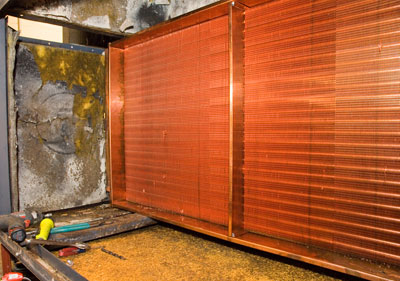July 22, 2009
FOR IMMEDIATE RELEASE
Antimicrobial Components Being Tested for Increased Efficiency and Odor Prevention.
NEW YORK, NY— If you turn on your car air conditioner on a hot summer day and are overwhelmed by the smell of mildew, it is because mold is growing in the air conditioner unit. The same phenomenon occurs on a larger scale in the heating and air conditioning (HVAC) units of buildings. HVAC units provide dark, moist environments—perfect breeding grounds for the bacteria and fungi that are associated with foul odors and decreased efficiency. To combat this phenomenon, the U.S. Department of Defense is funding research into antimicrobial copper components that can control the growth of organisms that grow in HVAC units. The units are installed at the military barracks at Fort Jackson in Columbia, SC.
 Aluminum cooling coil fins
Aluminum cooling coil fins Copper cooling coil fins
Copper cooling coil finsCharles Feigley, Ph.D., Professor of Environmental Health Sciences at the University of South Carolina, and principal investigator for the study, explained the need for this research, "Improvements in building and construction methods have generally led to increased energy efficiency, but at the same time, these 'tighter' building envelopes tend to trap bacteria, leading to odors. The results of this real-world trial should encourage advancements in the design of HVAC systems."
The Ft. Jackson trial is comparing the ability of antimicrobial copper HVAC components with the more commonly used aluminum components in controlling the growth of odor-causing bacteria and fungi in HVAC units. Components being replaced with copper are those in which microbial contaminants tend to thrive—cooling coils, heat exchange fins and drip pans. The trial is designed to test the effectiveness of copper surfaces in inhibiting the growth of microbes which are not only the source of foul odors, but can also build up on heat transfer surfaces and compromise the thermal efficiency of the unit. In addition to being antimicrobial, the copper elements are highly recyclable and are better thermal conductors than their aluminum counterparts.
 Copper Heat Exchanger
Copper Heat ExchangerIn conjunction with the real-world field trial at Ft. Jackson, a controlled laboratory study is taking place at the University of South Carolina in the Arnold School of Public Health.
In addition to the trials, the Copper Development Association is pursuing U.S. Environmental Protection Agency (EPA) registration of copper alloys for use in protecting HVAC components.
The copper cooling coils, heat exchange fins and drip pans were manufactured by Luvata, a leading metal fabrication and component manufacturing company.
###
